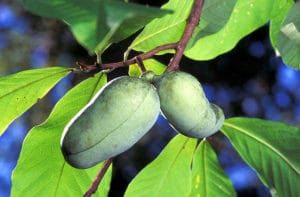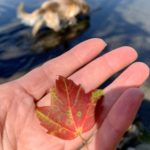Hello fellow readers, What a treat to gather a biweekly allotment at Genesis Farm in Blairstown, NJ, gifted by a client who’s become a friend. Nancy said her friend Lois would be there volunteering as a greeter if I picked up the provisions before two, which I did, and what a treat it was to meet her too.

The Fall bounty at Genesis Farm

What a delight to meet Lois, a volunteer greeter at Genesis Farm
Lois showed the system of how much of each treasure to gather. And the area where there were seconds or goodies – not part of the allocations. Amongst them were the fruits of a Pawpaw tree, smaller and uglier than usual (smile), leading to a chat about my friend Elsa, who passed away a few years back.
I intended to plant a Pawpaw tree in her memory and have yet to do so. My excuse—nurseries don’t often carry them, which is true. The God-incidence is that morning, I was revisiting the column honoring Elsa to include in a book underway. (Link to the column Fall is not Goodbye)
Starting Pawpaw trees from seed is tricky.
Lois said she looked up how to start a Pawpaw tree from seed and that they tend to dry out, so starting them can be tricky. She added, “perhaps planting the fruit whole would help keep them moist.” While not likely the way experts would suggest, it’s how Mother Nature starts some trees from fruit that has fallen to the ground.
Pawpaw is native to the eastern United States to Canada, zones 5 to 8, and grow in colonies creating a tropical appearance. They’re a fast-growing small tree that grows to thirty-five feet. Asimina triloba has other common names, such as Custard Apple, Hillbilly Mango, and Poor Man’s Banana. However, there’s nothing poor about the nutrients it provides. Rich in vitamins A and C, magnesium, zinc, iron, and potassium, the name Pawpaw is a derivative of Papaya as the fruit has some resemblance.

Pawpaw Fruit
Scott Bauer, USDA – USDA ARS Image Number K7575-8
It has a banana texture but tastes like a combination of pear and banana. Others say it tastes like vanilla custard with a bit of citrus. It’s eaten raw or used in baked goods — stay clear of the seeds, though, as they are considered poisonous.
Pawpaw fruit doesn’t last long.
The fruit is not often sold at grocers as they have a short shelf life—two or three days or a week if chilled. Not a problem for home growers, though, as you can freeze the flesh and use it in smoothies or ice cream. Pick them just as they ripen before falling from the tree as they ferment to an astringent taste.
Seeds need 60-100 days of cold and moist stratification, which you can do in a Ziplock bag with damp sphagnum moss (not wet) kept in a 32 to 40-degree frig. But I plan to let nature do her thing.
Plant pawpaw seeds before they dry out
If you remove the seeds from ripened fruit and then wash and plant them immediately in the ground in the Fall, they’ll likely germinate and sprout shoots in the following Summer. They won’t set fruit for five to eight years, but that’s okay. It’s the tree that I’m excited to have.
They say the best time to plant a tree is twenty years ago. And planting seeds may be the same thing. But I think the best time is when they come to you. Thank you for the gift.
Garden Dilemmas? AskMaryStone@gmail.com and your favorite Podcast App.

Speaking of the book underway, I’d love a few helpers to preview portions of my book. If you’d like to help me, please email me at AskMaryStone@gmail.com. Thank you, kind readers, and The Press, for over a decade of column chats. It means so much.
Link to a related story – What is a Pawpaw Tree? and the column honoring Elsa Fall is not Goodbye,
There’s much more to the story in Episode 82 of the Garden Dilemmas Podcast:


